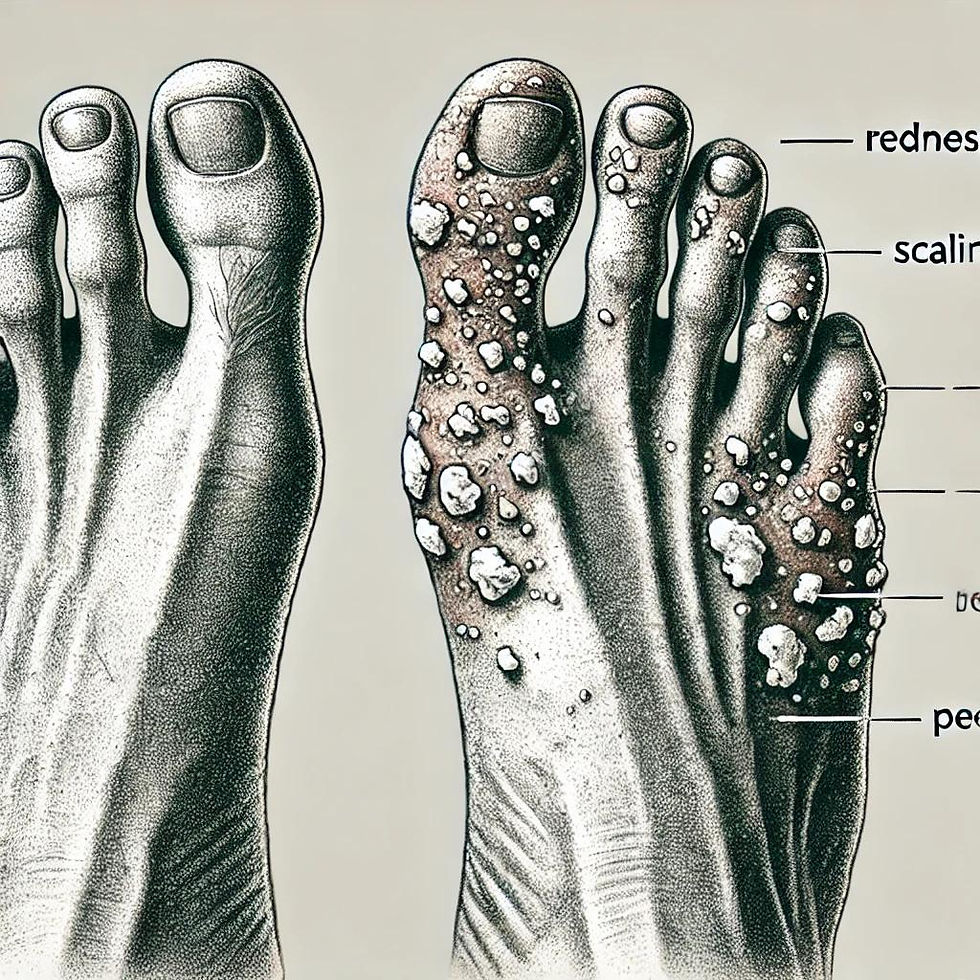Understanding Athlete's Foot: Causes, Symptoms, and Prevention
- Amit Goyal
- Jan 16
- 3 min read

Athlete's foot, medically known as tinea pedis, is a common fungal infection affecting the skin of the feet. It’s not only an annoyance but also a condition that can cause significant discomfort if left untreated. In this blog, we answer key questions about athlete's foot and provide tips on managing and preventing it.
What is Athlete's Foot?
Athlete’s foot is a fungal infection caused by dermatophytes—a group of fungi that thrive in warm, moist environments. The infection often begins between the toes but can spread to other parts of the feet. It may also affect the toenails and, in some cases, other areas of the body.
Is Athlete’s Foot Contagious?
Yes, athlete’s foot is highly contagious. It spreads through direct contact with infected skin or surfaces contaminated with the fungus, such as shared showers, swimming pools, gym floors, and towels. Wearing someone else’s shoes can also increase your risk of catching the infection.
Is Athlete’s Foot Itchy?
One of the hallmark symptoms of athlete’s foot is itchiness, particularly between the toes. In some cases, this itchiness can become severe, leading to skin irritation and discomfort. Other symptoms may include redness, scaling, cracking, and even a burning sensation.
Is Athlete’s Foot Permanent?
Athlete’s foot is not a permanent condition and can be treated effectively with antifungal medications. Over-the-counter creams, sprays, and powders are often sufficient for mild cases. Persistent or severe infections may require prescription-strength treatments from a healthcare professional.
Is Athlete’s Foot Common?
Yes, athlete’s foot is extremely common, affecting millions of people worldwide. It’s particularly prevalent among athletes, hence the name, but it can affect anyone, especially those who frequently use communal facilities or wear tight, non-breathable footwear for extended periods.
Does Athlete’s Foot Spread?
If untreated, athlete’s foot can spread to other parts of the body, such as the hands (tinea manuum) or groin (tinea cruris). Scratching the affected area can transfer fungal spores to other regions of the skin. It is essential to practice good hygiene and avoid touching or scratching the infected area.
Does Athlete’s Foot Spread to the Face?
While it is rare, athlete’s foot can spread to the face if fungal spores are transferred through contaminated hands or items like towels. This condition, called tinea faciei, can cause redness, scaling, and irritation on the face.
Who Gets Athlete’s Foot?
Athlete’s foot can affect anyone, but certain groups are more susceptible, including:
Athletes and individuals who frequent communal spaces like gyms and pools.
People with sweaty feet or those who wear tight-fitting shoes for prolonged periods.
Individuals with weakened immune systems.
Those with a history of fungal infections.
How to Prevent Athlete’s Foot
Prevention is key to avoiding athlete’s foot. Here are some tips to protect your feet:
Keep Feet Clean and Dry: Wash your feet daily and dry them thoroughly, especially between the toes.
Wear Breathable Footwear: Choose shoes made from materials that allow your feet to breathe. Avoid wearing the same pair of shoes two days in a row.
Use Antifungal Products: Apply antifungal powders or sprays to your feet if you are prone to excessive sweating.
Avoid Walking Barefoot in Communal Areas: Always wear flip-flops or shower shoes in public locker rooms and swimming pools.
Don’t Share Personal Items: Avoid sharing towels, socks, or shoes with others.
Seeking Treatment
If you suspect you have athlete’s foot, it’s important to address it promptly to prevent complications or spreading. Most cases can be managed with over-the-counter antifungal treatments, but if symptoms persist or worsen, consult a dermatologist for tailored advice and stronger medications.
Athlete’s foot is a manageable condition, and with proper care, you can prevent it from recurring. Protect your feet and maintain good hygiene to keep this pesky fungus at bay!